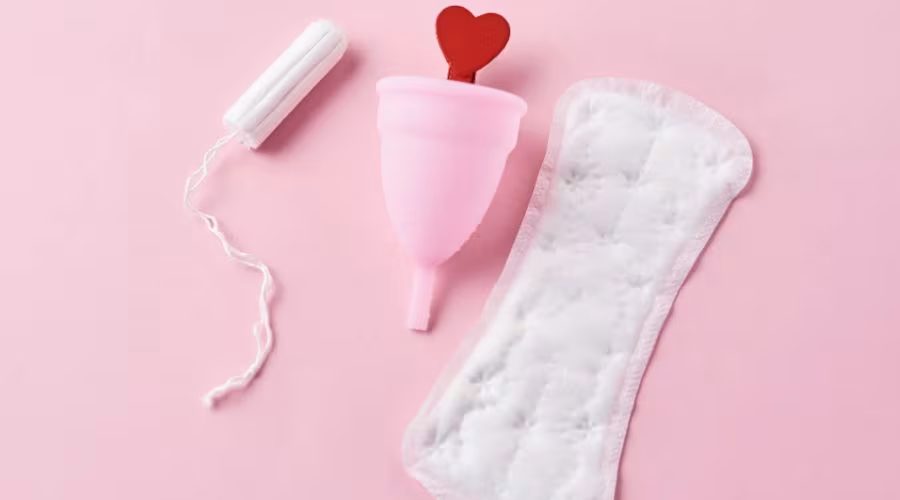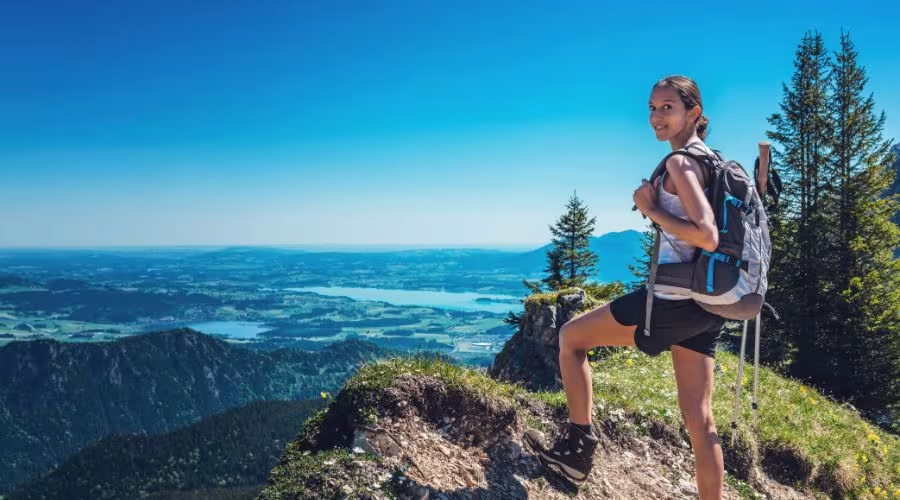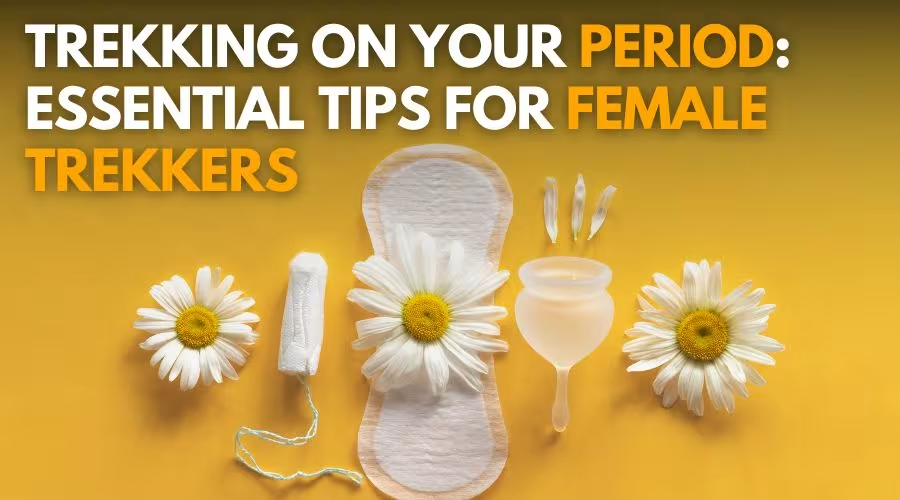Periods are a natural part of life, but it shouldn’t stop you from enjoying the outdoor adventures of hiking and trekking. While the thought of managing your period in the wilderness might seem scary, with proper preparation and knowledge, it can be a comfortable experience. This comprehensive guide gives practical tips for managing your period and trekking during periods.
Table of Contents
Preparation before the Trek
Track your cycle: First things first—know your cycle. This helps you pack appropriately, prepare mentally, and make informed decisions about your trekking itinerary. Choose the right Menstrual Products:

1) Menstrual Cups:
A menstrual cup is a game-changer for many trekkers. It’s reusable, eco-friendly, and holds more blood than a pad or tampon (8-12 hours of protection). Plus, it creates less waste, which is ideal for “Leave No Trace” trekking.
Pro Tips:
- Practice using it before your trek if you’re new to cups.
- Sterilize it before your trip.
- Wash with clean water or use a sanitizer during the trek.
- Always carry hand sanitizer and a small bottle of water for cleaning in remote areas.
2) Tampons:
Tampons are compact, lightweight, and easy to use, especially for active days. But they do create waste, and you’ll need to safely pack out your used ones.
Pro Tips:
- Choose tampons without applicators to reduce waste.
- Store used tampons in a ziplock cover with a bit to control odour until you can dispose of them responsibly.
3) Sanitary Pads
Pads are the easiest option if you’re not comfortable with products that require insertion. They’re simple, widely available, and familiar. But, they can feel bulky and aren’t ideal for heavy physical activity like trekking.
Pro Tips:
- Use ultra-thin, high-absorbency pads to reduce bulk.
- Change regularly to avoid rashes and discomfort.
- Always pack used pads in ziplock bags. Please don’t bury or burn them.
4) Period Underwear
Period underwear looks like regular panties but has built-in absorbent layers that hold up to 8-12 hours without any leakages. No, you don’t have to wear pads with it. This might be an option for shorter treks. But given the washing process, and unavailability of such facilities in the wilderness, this might not be the right option.
Personal Hygiene Kit: Pack biodegradable wet wipes, hand sanitiser, disposal bags for used products to ensure you don’t leave any waste behind on the mountains.
Pain Relief Medications: Not everyone is lucky to have painless periods, but we also want to go out there doing what we love. So, carry pain reliever medications to manage cramps as per doctor’s advice. If you prefer natural ways, carrying a hot water bottle might serve the purpose too.
Comfortable Clothing: Choose breathable clothing for comfort and moisture-absorbing undergarments to avoid rashes.
Mental preparation: Above all, mentally prepare yourself for any challenges.
Read a detailed guide on the best Menstrual Product for Treks
Managing Periods During the Trek

a) Managing Cramps:
Pain management can make or break your trekking experience. Here’s what helps:
- Stay hydrated – water helps reduce bloating and cramping.
- Take breaks when you feel fatigued. Don’t push yourself hard, listen to your body. Inform your trek leaders accordingly.
- Gentle movement actually eases cramps. Please don’t stay still for long periods.
- Pack painkillers like Ibuprofen or Meftal and take as prescribed.
- Use a reusable heat pad or warm water bottle on your lower abdomen at camp (if possible).
- Try herbal teas like ginger, spearmint or chamomile if you have access.
- And no, animals are not attracted to period blood. Studies have shown that only iguanas might be, but the chances of attack are very less.
b) Dress for Comfort and Protection
When you are trekking for long distances, leaks and rashes are the last thing you want to be dealing with. What you wear makes a difference and helps you stay comfortable
- Dark-colored tights or trekking pants hide leaks better.
- Wear quick-dry, moisture-wicking underwear. Pack a couple of extra as backup.
- Use panty liners on light days or as backup.
- A lightweight scarf or sarong can double up as a changing cover or towel.
c) Eat Right and Stay Energized
Periods drain energy, and trekking does too—so fuelling your body is important to help you stay energised. You can easily pack them from home, in small and accessible quantities.
- Eat foods rich in iron (dates, raisins, leafy greens) to compensate for blood loss.
- Bananas and dark chocolate help with cramps and mood swings.
- Stay away from overly salty or processed snacks—these worsen bloating.
- Carry trail mix, protein bars, and herbal teas to stay nourished and energized.
d) Waste Disposal
Yes, waste disposal includes period waste, and it is important to ‘Leave No Trace’
- Carry a few ziplock bags
- Wrap used pads/tampons in tissue and seal in ziplocks.
- Sprinkle a little baking soda or coffee grounds inside to control odour.
- NEVER bury or burn menstrual waste—carry it out and dispose properly once back.
- There are also portable sanitary disposal bags available, if you want something more discreet and hygienic.
e) Maintain Hygiene
Managing hygiene without bathrooms is tricky and confusing, but it is manageable.
- Wipe front to back to avoid infections.
- Clean with wipes or a wet cloth during the day.
- Use hand sanitizer before and after changing.
- Wash your intimate area at camp with water.
- Change your pad/tampon/cup regularly—don’t wait for leaks.
- If you’re using reusable products (cups or period underwear), rinse with water.
f) It’s okay to Slow Down
Periods are tough, don’t be tougher on yourself. It’s okay to go slow, be kind to yourself. It’s okay to take a break. Your body is working a hard time, so don’t be too hard on yourself. Don’t compare your pace to others. If trekking with a group, inform someone you trust (like a trek leader) about your period—they’ll understand if you need a slower pace or extra support. If trekking solo, take breaks and do whatever lightens your mood and feel better; it could be listening to calming music or just sitting at watching the mountains in peace.
Nothing should come in the way of your adventures, not even your periods. The experience can be hard, but need not be limiting. Remember that everyone’s body and preferences are different—what works for one person may not work for another. Don’t be afraid to test different methods on shorter hikes before committing to longer treks. Most importantly, don’t let your period stop you from enjoying the trails and the beauty of connecting with nature.

Leave a Comment